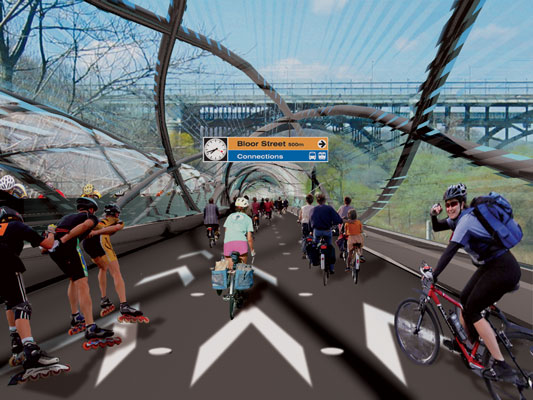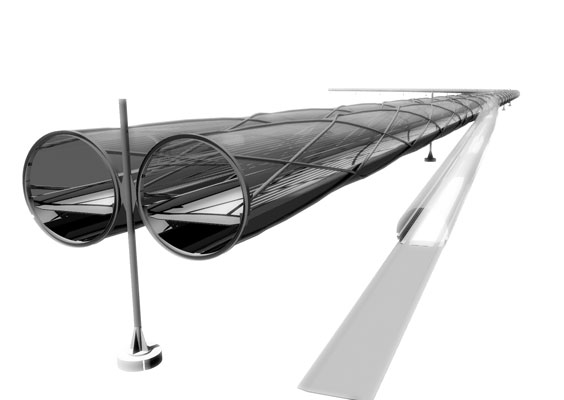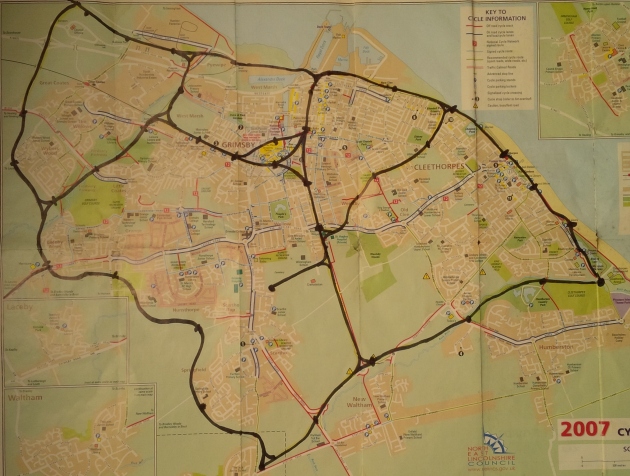I concluded the last post in this series by saying:
As things stand, massive amounts of money have been allocated to the budget for implementing the vision for our roads over the years. But what if, having seen the huge benefits cycling brings, a large part of the transport budget was devoted to implementing the new vision of healthy, sustainable urban transport? What if, instead of integrating the car into all the planning decisions, it was the bicycle that featured in the centre of the planning decisions? And by doing so, as well as the existing cycling benefits of health, wealth and environmental goodness, we could add safety, comfort and convenience?
The Dutch have demonstrated how to integrate cycling into existing road infrastructure, and by consistently designing this into their road plans, they have created a very desirable network of relatively safe cycleways. I say relatively, because, although he Netherlands is without doubt the safest country in the world to be a cyclist, I was surprised to read the following statistics on cycling accidents and deaths in the Netherlands:
In 2009, there were 185 cyclists killed on Dutch roads. In 2010, that number was 162 killed and in 2011 there were 200 cyclists killed.
These figures surprised me, I expected them to be lower, given the excellent cycling infrastructure in The Netherlands. This reminded me of a BBC documentary I saw in the mid 1990’s about the Russian Federation following the collapse of the Soviet Union. It was a time of economic crisis and difficult transition. The question was though, a transition to what exactly? One young profession Russian was interviewed on the streets of Moscow and his comments struck me. He said that Russia had left the Communist days behind, and many in the country were looking to become like the West. But he said, if Russia aimed at where the West was then, by the time Russia had arrived at that point, the West would have moved on and Russia would still be behind. Rather than imitate the West as it was then, he suggested why not look to the direction the West was heading in and aim there instead.
This was an insightful comment and we can apply it to our cycling vision for the future. What the Netherlands has today has taken decades of consistent planning and funding, and we are not going to be able to replicate it here in the UK overnight. So, instead of copying where the Netherlands is now, why not look beyond that and plan for the future, something better than exists today?
What the Netherlands has done is demonstrate how to incorporate cycling into everyday life, sharing the road space with other traffic by building separated cycleways. However, I believe this is only part of the “ideal”. Cycling on these cycleways is still unpleasant when the rain is pouring down and the wind howling in your face. And the statistics show people are still being killed whilst cycling in the Netherlands. So, as good as it is there, and it is the best in the world at present, it’s still far from perfect.
I believe there is a way to build both on the Dutch shoulders, so to speak, and to incorporate the thinking of architects like Chris Hardwicke and Steven Fleming, to create something that is truly a step into the future, a giant stride forward instead of nibbling around the edges of minor infrastructural improvements.
Taking all these thoughts and factors into account, what then is the way forward? By taking the ideas of Chris Hardwicke in Toronto and developing them further, I propose a completely new and radical approach that incorporates all the existing cycling benefits of health, wealth and environmental goodness, and combines them with safety, comfort and convenience. A network of urban “motorways” for cycling! This vision is for a low-tech urban mass transit system, far more cost-effective, efficient and environmentally friendly than the alternative of ever increasing levels of motor vehicle use. It is a system of enclosed, one-directional back-draughted tubes, elevated above existing roads and rail lines, forming a perfect environment for urban cycling, fully protected from the weather. We could call it the Bike Tube!

Velo-City proposal in Toronto. In NE Lincs, this would be pairs of enclosed, uni-directional tubes, with a constant back wind enabling comfortable and safe urban cycling. Image from velo-city.ca
_________
Imagine the scene: It’s a cold, wet and windy Monday morning, and you’re about to leave for work. You put on your coat, hat and gloves, and cycle the short distance from your home (for example, on Middlethorpe Road), along the separated cycleway to the nearest junction of the Bike Tube at Humberston, near Tesco’s. Your keyless-entry fob in your pocket opens the automated gate and you proceed up the entry ramp, assisted by the moving elevator up to the Tube itself. As you enter, you’re suddenly in a different world.
Riding along in a 3-4m wide transparent tube, you’re protected from the wintry conditions outside. Instead of riding into a head wind, you’re now riding along comfortably at 15-20 mph because of the continuous back wind flowing throughout the length of the Tube. It’s not at all cold in the Tube, just a pleasant ambient temperature, perfect for cycling. There are no motorised vehicles here, no traffic lights and no pedestrians, just cyclists, hundreds of them, all moving comfortably, safely and quickly around the network to their destinations. Each of the various junctions you pass, with their ramps down to the streets below, are signed and laned off, and other cyclists move into those lanes to leave the Tube at those junctions, just like on a motorway for cars.
Many exit in the centre of town at the train station, others have branched off to head for the major indoor junction on the first floor at Freshney Place, but you carry on. You’ve still got another 15 minutes until you reach your junction at Immingham Docks, but it’s no problem. Far from it – you’re comfortable and enjoying the view as you ease along the elevated Tube, the rain pounding against the Tube while you serenely cycle above the train line out of town before cutting through the industrial areas and on up to your exit junction, just half a mile from your place of work.
_________
OK, it’s just a scenario, but it’s trying to paint a picture of what it could be like. The Bike Tube is a network of elevated tubes, one in each direction, with a flow of air throughout the length of the Tube in the direction of travel. This provides a perfect environment for cycling even long distances. Each terminus of each tube would have a fan generating the back-draft, and this could be supplemented by smaller thruster fans along the route. The ceiling of each tube could incorporate solar panels to generate all the power required during daylight hours, with renewable energy used during the hours of darkness. During darkness, sensors detect the presence of cyclists and ensure each forward segment is lit for their passage through that section, thus saving power.

The Bike Tube has a small ground footprint (the support column) and features two “carriageways” of tubes, one in each direction, just as in a motorway for cars. The NE Lincs Bike Tube would incorporate solar panels along the ceiling of each tube, and could be screened when passing through sensitive areas by tall trees such as Poplars. Image from Velo-City.ca
Such a network of Bike Tubes would elevate cycling, with all its inherent benefits, to the level of use that we see cars have today – a stunning urban transport revolution. At the junctions of the Tube, there would be a connected network of Dutch-style (ie, separated from the road) cycleways, including an exit/entrance cycle roundabout (as with motorways today), so that the Tube is integrated within the overall network, much as motorways are connected to urban roads. It’s exactly the same principle, only this time for bikes!
The main routes for the Tube in NE Lincs would initially be built over existing rail lines and along Peakes Parkway (previously a rail line), with additional routes added to complete the network. Main termini would be at Waltham and Meridian Point in Cleethorpes in the south, with a spur from Peakes Parkway to Scartho and a longer spur from Laceby Acres (Morrison’s) to Laceby. Nowhere within the Grimsby/Cleethorpes area would be more than a mile from a Bike Tube junction.

A map of the proposed Bike Tube network in Grimsby and Cleethorpes. (click to enlarge)
The Bike Tube would continue along the Humber bank from Europarc, serving the main industrial areas there, spurring off to connect Stallingborough, then continuing onwards to Immingham Dock, Immingham town and on to the oil refineries and northwards to HST and, very importantly, the huge forthcoming Able UK development. It will be massively important to be able to accommodate the large numbers of people commuting to this area in an environmentally friendly way. The Bike Tube would realistically enable mass commuting to these areas from Grimsby, Cleethorpes and Immingham by bicycle.
The running costs could be covered, at least in part, by an annual charge, for instance, of £30 for access to the Tube network. Initial development and funding would of course be major issues, but given the huge potential ongoing benefits such an innovative solution would provide (improved health for all cycling instead of driving, reductions in road maintenance costs due to reduced volumes of motor traffic, increased tourist interest in the area, etc) such costs (which could partly be borne by central Government and private industry) would surely be more than justified in the long term. The Bike Tube footprint on the ground would be minimal (just the support columns and entry/exit ramps), and where it passes by housing (kept to an absolute minimum) or other sensitive areas, such as close to the cemetery, it could be screened by planting tall trees such as Poplars.
Of course, this would be a radical development and no doubt would be controversial. I believe its significance is on a par with the development of the railway back in the 1800’s. However, as I described in earlier parts of this series, we need a radical rethinking of urban transportation. This solution is a sustainable, clean, green, quiet, low cost, health-inducing form of mass urban transit.
The Bike Tube network would be a landmark structure, a tourist attraction for the area. It also would be an innovative solution to the various aspects of urban transport – environmental, noise pollution, petrol/diesel fume pollution, and congestion on the roads. By making it practical and convenient for people to leave the car at home and go by bike, the roads themselves would be quieter with fewer cars, and subsequently fewer traffic accidents. It represents a solution that I believe would take us forward as a society.






